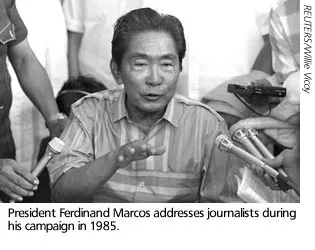Return to “On the Radio, Under the Gun”
| The pivotal role of the Philippine press in the nation’s history is a point of pride among journalists. The newspaper La Solidaridad, published in Spain and distributed to intellectual reformers in the Philippines, was a mouthpiece for revolutionary sentiment against the Spanish at the end of the 19th century. One of its principal contributors, the author and national hero José Rizal, was executed by the Spanish in 1896 for being the intellectual inspiration for the independence movement.
After the United States took control of the islands from Spain in 1898, thwarting the drive for independence, the spread of the English language led to the establishment of a number of American-owned newspapers. They included the Manila Bulletin, which was founded in 1899 and still publishes today. American-style journalism flourished; its florid language, tradition of standing apart from government, and use of outspoken columnists became the norm. The first private radio stations in Asia were established during the period, and because of American influence, the Philippines was the only country in the region where the government did not own or tightly control the broadcast media. By the 1930s, the press was well-established and Filipinos were moving into positions of ownership and influence, beginning a tradition of powerful families investing in the media to cement political and business influence. After the United States granted the nation independence in 1946, the Philippine media quickly gained the reputation it still enjoys as the freest press in Asia. At a time of economic prosperity, powerful newspapers sent foreign correspondents abroad to cover the Korean War. A number of influential journalists gained reputations in the 1950s and ’60s for investigating government corruption and exposing wrongdoing. Weekly publications such as the Philippine Free Press produced powerful pieces on social issues in a literary style that was immediate and impassioned. While many newspapers tailored their editorial stances to favor their owners’ political ambitions, others became vehicles for world-class journalism. Toward the end of the Marcos era, restrictions eased, corruption ate away at the regime, and public discontent grew. In the early 1980s, an alternative press emerged to challenge the government’s version of events and a handful of outspoken columnists in the mainstream press–nearly all of them women–began chiding the regime with devastating effect. When opposition leader Benigno Aquino was murdered as he stepped off a plane that returned him from exile in 1983, this independent press grew in power. By the time of the failed 1986 elections and the so-called “people power” revolt that brought Benigno’s widow, Corazon Aquino, to power, the press had played a major role in undermining Marcos. It was only fitting that, in the dramatic few days of the February 1986 revolt, many of the key street battles centered on radio and television stations. When the government lost control of its main television station, Channel 4, and jubilant pro-Aquino announcers went on the air, Marcos’ struggle to hold power was lost and he fled the country in a matter of hours. After Aquino took power, dozens of new newspapers were set up, the old Marcos cronies were out, and former owners of TV and radio empires returned from exile to reclaim their properties. The old order re-emerged; powerful families again saw the media as their domain. But consistent with the role the press played in the defeat of Marcos, there has also been an ongoing effort to hold government in check. When former President Joseph Estrada was ousted in 2001, the press ran detailed stories on his administration’s corrupt ways. Today, a series of corruption scandals ensnaring President Gloria Arroyo is being thoroughly and breathlessly aired in the media. Aquino’s promise of reform, meanwhile, has been unfulfilled. Government has grown more corrupt and the country poorer. According to most observers, the return to power of traditional elites in the post-Marcos period, especially in rural areas, has weakened the rule of law. Given the tradition of muckraking in the press, this has often left journalists, columnists, and broadcasters in the position of serving as almost the only check on local corruption in rural provinces. With many of these journalists lacking professionalism, training or an ethical base, they have become easy targets for attack. A. Lin Neumann is executive editor of The Standard of Hong Kong and a former program coordinator for the Committee to Protect Journalists. Neumann wrote about the violence in The Standard. Read his story at: http://www.thestandard.com.hk/stdn/std/Weekend/GG30Jp01.html |
 Then came martial law. When President Ferdinand Marcos imposed one-man rule in 1972, one of his first targets was the press. All radio, television and newspapers were shut down, and the few that were allowed to reopen were placed in the hands of trusted cronies. Strict censorship was put in place. The best publications, like the Free Press, were shuttered and their publishers and editors were jailed for a time.
Then came martial law. When President Ferdinand Marcos imposed one-man rule in 1972, one of his first targets was the press. All radio, television and newspapers were shut down, and the few that were allowed to reopen were placed in the hands of trusted cronies. Strict censorship was put in place. The best publications, like the Free Press, were shuttered and their publishers and editors were jailed for a time.